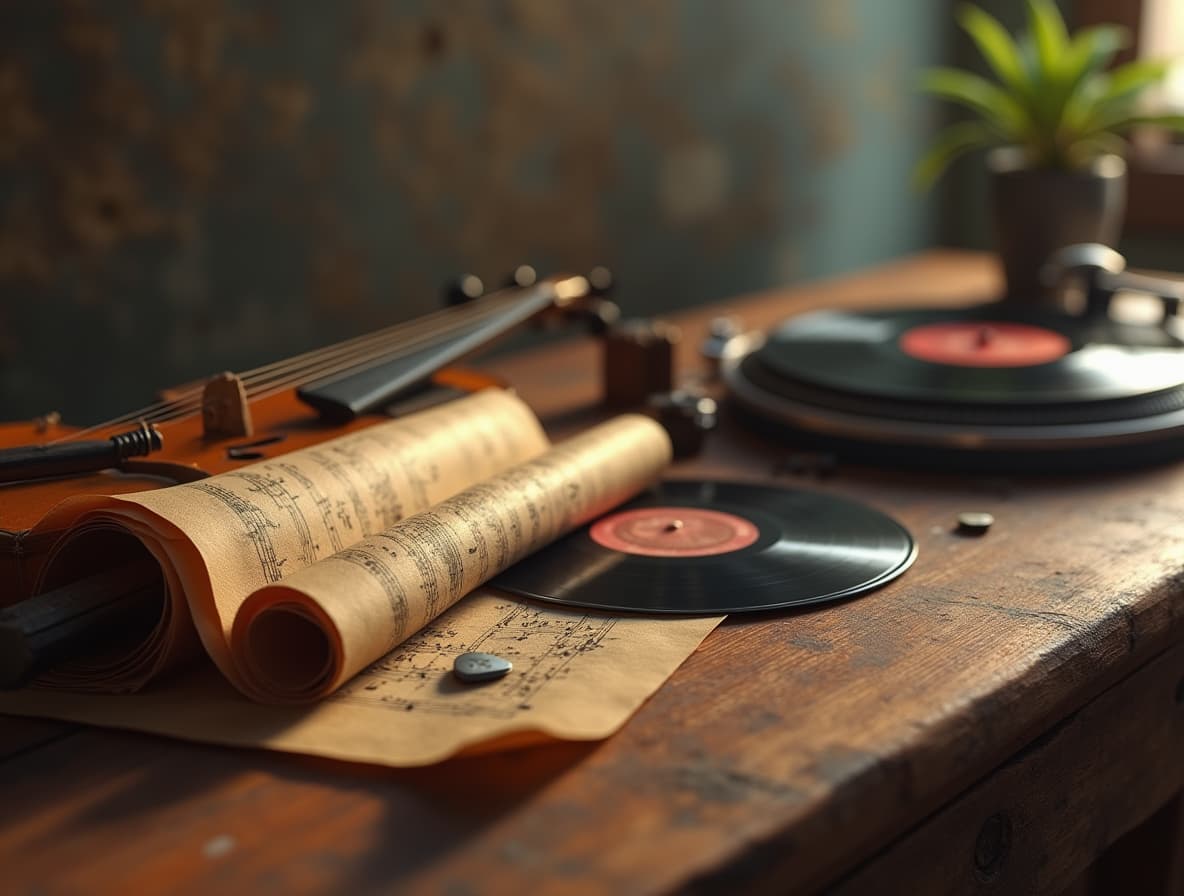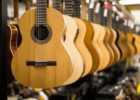Jump Through Time: Your Friendly Guide to Music History Eras
Ever wonder how we got from medieval chants to the driving beat of electronic music? Music wasn’t born overnight! It’s a constantly evolving story, with each era building on the last, creating the incredible soundtrack to human history we enjoy today.

Think of this page as your time machine. We’ll journey through the key periods in Western music history, exploring the sounds, ideas, and iconic figures that shaped each epoch. Understanding where music came from helps us appreciate where it is now – and where it might go next.
Ready to explore the timeline? Let’s go!
Contents
- 1 The Very Beginning: Medieval Music (Approx. 500 – 1400)
- 2 Rebirth and Harmony: Renaissance Music (Approx. 1400 – 1600)
- 3 Drama and Ornament: Baroque Music (Approx. 1600 – 1750)
- 4 Elegance and Order: Classical Music (Approx. 1750 – 1820)
- 5 Emotion Unleashed: Romantic Music (Approx. 1815 – 1910)
- 6 New Sounds Emerge: Early 20th Century & Beyond
- 7 The Rock & Roll Revolution (1950s onwards)
- 8 Soul, Funk, and Pop Take Over (1960s onwards)
- 9 Hip Hop Culture Emerges (1970s onwards)
- 10 The Electronic Wave (1970s onwards)
- 11 Music Never Stops Changing
The Very Beginning: Medieval Music (Approx. 500 – 1400)
- What’s the Vibe? Think church chants and wandering minstrels. Music was primarily functional, often religious or for storytelling.
- Key Characteristics:
- Dominated by vocal music, especially Gregorian chant (monophonic – a single melody line).
- Later development of polyphony (multiple independent melody lines).
- Simple instruments like lutes, recorders, and early fiddles were used by traveling musicians (troubadours/minstrels).
- Music notation was just beginning to develop.
- Who to Listen To: Hildegard von Bingen, Pérotin, Guillaume de Machaut. (Finding recordings can be an adventure!)
Rebirth and Harmony: Renaissance Music (Approx. 1400 – 1600)
- What’s the Vibe? A “rebirth” of arts and culture led to richer, more complex music, moving beyond purely religious functions. Harmony becomes key.
- Key Characteristics:
- Smoother, more flowing melodies than in the Medieval era.
- Increased use of polyphony, with intricate vocal harmonies (motets and madrigals were popular).
- More instrumental music, development of instrument families (like viols).
- Focus on clarity, balance, and expressing the text more directly.
- Who to Listen To: Josquin des Prez, Palestrina, William Byrd, Claudio Monteverdi (straddles Renaissance/Baroque).
Drama and Ornament: Baroque Music (Approx. 1600 – 1750)
- What’s the Vibe? Grand, elaborate, and emotional. Think of ornate decorations but in sound. Opera is born!
- Key Characteristics:
- Strong contrasts (loud vs. soft, solo vs. ensemble).
- Complex counterpoint (weaving multiple melodies together, like in a fugue).
- Development of major/minor key system we still use.
- Rise of instrumental music: the concerto, sonata, and suite become important.
- The harpsichord and organ are key keyboard instruments.
- Who to Listen To: Johann Sebastian Bach, George Frideric Handel, Antonio Vivaldi, Henry Purcell.
Elegance and Order: Classical Music (Approx. 1750 – 1820)
- What’s the Vibe? Lighter, clearer, and more elegant than Baroque. Focus on balance, structure, and beautiful melodies. Think powdered wigs and symphonies.
- Key Characteristics:
- Emphasis on clear melodies with simple accompaniment (homophonic texture).
- Well-defined musical forms like the sonata form, symphony, and string quartet.
- Larger orchestras begin to take shape.
- Focus on balance, proportion, and restraint (compared to Baroque drama).
- Who to Listen To: Wolfgang Amadeus Mozart, Joseph Haydn, Ludwig van Beethoven (early-middle works).
Emotion Unleashed: Romantic Music (Approx. 1815 – 1910)
- What’s the Vibe? All about feeling! Music becomes intensely personal, expressive, and dramatic. Think big emotions, epic stories, and individualism.
- Key Characteristics:
- Focus on expressing deep emotions (love, death, nature, nationalism).
- Larger orchestras with new instruments add color.
- Greater dynamic range (very soft to very loud).
- More complex harmonies and exploration of chromaticism (notes outside the standard scale).
- Rise of the virtuoso performer.
- Who to Listen To: Ludwig van Beethoven (later works), Franz Schubert, Johannes Brahms, Pyotr Ilyich Tchaikovsky, Richard Wagner, Frédéric Chopin.
New Sounds Emerge: Early 20th Century & Beyond
The 1900s saw rapid changes and the splintering of styles. Technology starts playing a bigger role.
Impressionism & Modernism (Early 1900s)
- What’s the Vibe? Breaking the old rules. Impressionism evokes moods and atmospheres (like Monet’s paintings in sound), while Modernism experimented radically with harmony, rhythm, and structure.
- Key Characteristics: (Impressionism) Hazy harmonies, fluid rhythms, focus on instrumental color. (Modernism) Dissonance, complex rhythms, challenging traditional forms, and sometimes atonality (no key center).
- Who to Listen To: (Impressionism) Claude Debussy, Maurice Ravel. (Modernism) Igor Stravinsky, Arnold Schoenberg.
The Jazz Age (1920s onwards)
- What’s the Vibe? Born from African American communities in the US, blending blues, ragtime, and spirituals. Energetic, improvisational, and revolutionary.
- Key Characteristics: Improvisation is central. Syncopated rhythms (“swing”), call-and-response patterns, distinctive instrumentation (horns, piano, bass, drums). Many subgenres evolved (Swing, Bebop, Cool Jazz, etc.).
- Who to Listen To: Louis Armstrong, Duke Ellington, Charlie Parker, Miles Davis, John Coltrane.
The Blues Influence (Early 20th Century onwards)
- What’s the Vibe? The soulful sound of hardship and resilience was also born from African American experiences in the Deep South. The bedrock of much popular music.
- Key Characteristics: Specific chord progressions (12-bar blues), expressive/bent notes (“blue notes”), call-and-response vocals/instruments, themes of struggle and emotion. Evolved from acoustic Delta blues to electric Chicago blues.
- Who to Listen To: Robert Johnson, Muddy Waters, B.B. King, Howlin’ Wolf.
The Rock & Roll Revolution (1950s onwards)
- What’s the Vibe? Electrifying energy! Fusing blues, R&B, and country, rock & roll captured the spirit of youth rebellion and became a global force.
- Key Characteristics: Electric guitars, strong backbeat (drums), driving basslines, often simple chord structures, catchy melodies, vocal-centric. This led to countless subgenres (Rock, Punk, Metal, Alternative, etc.).
- Who to Listen To: Chuck Berry, Elvis Presley, Little Richard, The Beatles, The Rolling Stones (and countless others!)
Soul, Funk, and Pop Take Over (1960s onwards)
- What’s the Vibe? Soul brought gospel passion to R&B. Funk emphasized infectious rhythm and groove. Pop focused on catchy tunes for mass appeal.
- Key Characteristics: (Soul) Passionate vocals, horn sections, strong rhythms. (Funk) Syncopated basslines, tight drum grooves, rhythmic guitar. (Pop) Catchy hooks, polished production, and relatable lyrics evolved with technology (Synth-Pop, etc.).
- Who to Listen To: (Soul) Aretha Franklin, James Brown, Marvin Gaye. (Funk) Sly & The Family Stone, Parliament-Funkadelic. (Pop) Michael Jackson, Madonna, ABBA.
Hip Hop Culture Emerges (1970s onwards)
- What’s the Vibe? More than music – a culture from the Bronx, NYC. Rhythmic speech (rapping) oversampled or synthesized beats, built on DJing and MCing.
- Key Characteristics: Focus on rhythm and rhyme. Sampling (using parts of other songs). Turntablism (manipulating records). Drum machines. Diverse lyrical themes (social commentary, storytelling, boasting). Evolved through Old School, Golden Age, Trap, etc.
- Who to Listen To: Grandmaster Flash, Run-DMC, Public Enemy, A Tribe Called Quest, Tupac Shakur, The Notorious B.I.G.
The Electronic Wave (1970s onwards)
- What’s the Vibe? Music is made with synthesizers, drum machines, and computers. From experimental sounds to massive dance floor anthems.
- Key Characteristics: Synthesized sounds and textures. Repetitive beats. Focus on rhythm and atmosphere. Technology is integral to the sound. Huge range of subgenres (Ambient, House, Techno, Trance, Drum & Bass, etc.).
- Who to Listen To: Kraftwerk, Giorgio Moroder, Daft Punk, Aphex Twin, and various pioneers of House/Techno like Frankie Knuckles, and Juan Atkins.
Music Never Stops Changing
This timeline gives you a glimpse into the incredible journey of music. Notice how styles borrow, blend, and react to each other? From ancient chants to digital beats, the story of music is the story of human creativity.
What sounds will the future bring? Keep listening, keep exploring!

